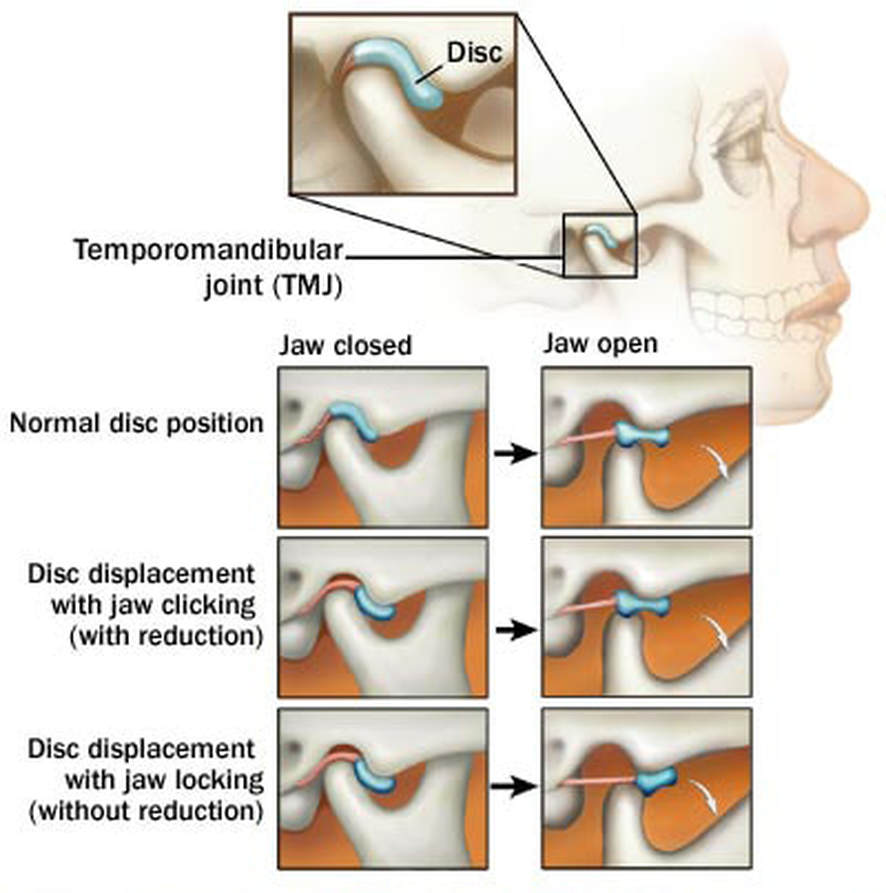CENTERED BODYWORK- STRUCTURAL INTEGRATION, CRANIOSACRAL AND ORTHOPEDIC MASSAGE
temporomandibular joint disorders (TMJD)
TMJD can be caused by emotional stress, whiplash, problems with the jaw itself (bite alignment), problems with TMJ (e.g. osteoarthritis), head trauma, tension in surrounding facial muscles that control movement of the jaw, as well as restrictions in the neck and and temporal bones issues. Occasionally restrictions are found further away that are causing the issue, particularly in the pelvis.
Common symptoms of TMJ disorders include:
It is very important to get early treatment because the TMJ can wear down and cause irreparable damage. It is an easily dislocated joint and the padding of the joint can be worn down if not in proper alignment. Once this happens surgery may be needed and is unlikely to help much.
Orthodontists treat the disorder by realigning the joint through force, however intraoral and external massage of the affected muscles and craniosacral therapy allow the joint to unwind and realign itself. Massage is often more effective, faster and cheaper than more forceful and expensive dental treatments. The aim of treatment is to both relax the TMJ so it can open more easily and even more important, to balance both sides. An unbalanced jaw (left and right) is most problematic because it can force one side to open first and slip off the joint disc. I combine many different techniques to support unwinding, including craniosacral therapy, massage, facilitated stretching, myofascial release, and intraoral bodywork work with gloves.
TMJD is one of the more challenging disorders to treat. It may take a greater number of sessions than other structural issues to fix, however you will know in 1-3 treatments whether it is working. Like any complicated disorder, occasionally there can be a temporary regression, so it's best to time the start of treatment when you can be available for subsequent treatments if needed. Most, but not all cases of TMJD can be solved with appropriate bodywork.
TMJD can be caused by emotional stress, whiplash, problems with the jaw itself (bite alignment), problems with TMJ (e.g. osteoarthritis), head trauma, tension in surrounding facial muscles that control movement of the jaw, as well as restrictions in the neck and and temporal bones issues. Occasionally restrictions are found further away that are causing the issue, particularly in the pelvis.
Common symptoms of TMJ disorders include:
- Pain or tenderness in the face, jaw joint area, neck and shoulders, and in or around the ear when you chew, speak or open your mouth wide
- Limited ability to open the mouth very wide
- Jaws that get "stuck" or "lock" in the open or closed position
- Clicking, popping or grating sounds in the jaw joint when opening or closing the mouth
- Difficulty chewing or a sudden uncomfortable bite, as if the upper and lower teeth are not fitting together properly
- Grinding teeth at night or under stress can be a cause and a symptom
- Seemingly unrelated issues: headache, neck pain, dizziness, ear ache, hearing problems, shoulder pain, tooth pain, tinnitus.
It is very important to get early treatment because the TMJ can wear down and cause irreparable damage. It is an easily dislocated joint and the padding of the joint can be worn down if not in proper alignment. Once this happens surgery may be needed and is unlikely to help much.
Orthodontists treat the disorder by realigning the joint through force, however intraoral and external massage of the affected muscles and craniosacral therapy allow the joint to unwind and realign itself. Massage is often more effective, faster and cheaper than more forceful and expensive dental treatments. The aim of treatment is to both relax the TMJ so it can open more easily and even more important, to balance both sides. An unbalanced jaw (left and right) is most problematic because it can force one side to open first and slip off the joint disc. I combine many different techniques to support unwinding, including craniosacral therapy, massage, facilitated stretching, myofascial release, and intraoral bodywork work with gloves.
TMJD is one of the more challenging disorders to treat. It may take a greater number of sessions than other structural issues to fix, however you will know in 1-3 treatments whether it is working. Like any complicated disorder, occasionally there can be a temporary regression, so it's best to time the start of treatment when you can be available for subsequent treatments if needed. Most, but not all cases of TMJD can be solved with appropriate bodywork.

